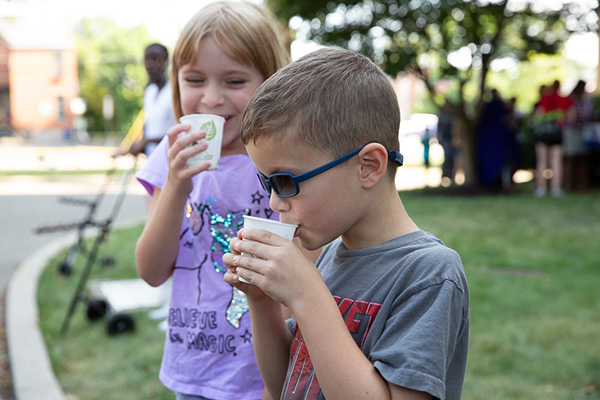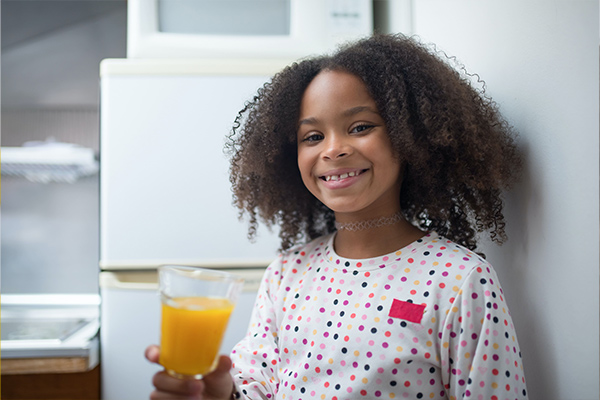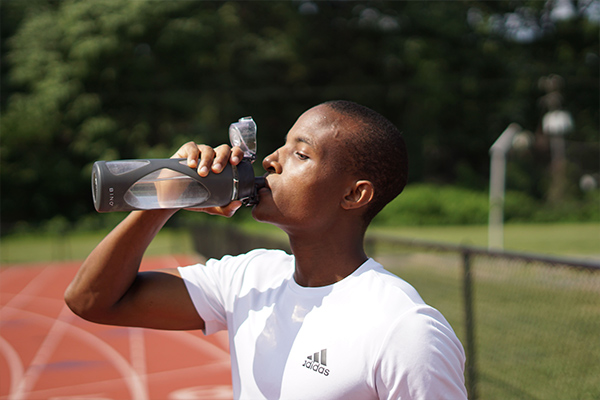
Recommendations by Age
Click an age range to learn how to stay healthy with the right drinks, in the right amounts, at the right ages, from age 5 to Adult.
WHAT TO DRINK:
- Water
- Plain Water including carbonated water with no added sweeteners, is the best way to quench your child’s thirst.
- The amount of water each child needs varies day-to-day based on how active they are, the weather, or the amount of fluids they get from other beverages like milk or foods like soups or applesauce.
- Milk
- Children should drink unflavored, low-fat (1%) and nonfat (skim) milk, or soy beverages (calcium and vitamin D fortified) in no more than 8-ounce portions.
- Children need up to 3 cups of milk or milk products (e.g., yogurt or cottage cheese) per day to meet nutrient needs.
WHAT TO LIMIT:
- 100% Juice
- 100% juice means that everything in the container came from a fruit or vegetable, with no added sweeteners or other ingredients. If a product is 100% juice it will state that on the front-of-pack label or on the Nutrition Facts Panel, and will have 0 g added sugars on the Nutrition Facts Panel.
- Children ages 5-10 should drink no more than 6 ounces of 100% fruit or vegetable juice or fruit juice combined with water, per day. Don’t add sweeteners like honey or table sugar.
- 100% vegetable juice should have no more than 100 mg of sodium per portion.
WHAT TO AVOID:
- Flavored milks (e.g., chocolate, strawberry)
- Caffeinated beverages (or those with stimulants)
- Low-calorie sweetened drinks (e.g., “diet” or “light” drinks)
- Sugary drinks (e.g., soda, fruit drinks and fruit flavored drinks, fruit-ades, sports drinks, energy drinks)
- Beverages with synthetic food dyes such as Red 40 and Yellow 5 on the ingredient list (e.g., fruit punch and other brightly colored beverages). Most kid’s fruit drinks contain synthetic food dyes.
- Beverage with stimulants (e.g., caffeine), and other additives (e.g., electrolytes, artificial flavors)
Taking care of little ones? Check out our healthy drinks guidelines for 0-5 year olds
WHAT TO DRINK:
- Water
- Plain water, and carbonated water, with no added sweeteners.
- Unflavored Milk
- Low-fat and nonfat milk or soy beverages (calcium and vitamin D fortified) in no more than 12-ounce portions.
WHAT TO LIMIT:
- 100% Juice
- 100% juice means that everything in the container came from a fruit or vegetable, with no added sweeteners or other ingredients. If a product is 100% juice, it will state that on the front-of-pack label or on the Nutrition Facts Panel, and will have 0 g added sugars on the Nutrition Facts Panel.
- Children ages 11-13 should drink no more than 8 ounces of 100% fruit or vegetable juice or fruit juice combined with water, per day. Don’t add sweeteners like honey or table sugar.
- 100% vegetable juice should have no more than 140 mg of sodium per portion.
WHAT TO AVOID:
- Flavored milks (e.g., chocolate, strawberry)
- Caffeinated beverages (or those with stimulants)
- Low-calorie sweetened drinks (e.g., “diet” or “light” drinks)
- Sugary drinks (e.g., soda, fruit drinks and fruit flavored drinks, fruit-ades, sports drinks, energy drinks)
- Beverages with synthetic food dyes such as Red 40 and Yellow 5 on the ingredient list (e.g., fruit punch and other brightly colored beverages). Most kid’s fruit drinks contain synthetic food dyes.
- Beverage with stimulants (e.g., caffeine), and other additives (e.g., electrolytes, artificial flavors)
WHAT TO DRINK:
- Water
- Plain water, and carbonated water, with no added sweeteners.
- Unflavored milk
- Low-fat and nonfat) or soy beverages (calcium and vitamin D fortified) in no more than 12-ounce portions.
WHAT TO LIMIT:
- 100% Juice
- 100% juice means that everything in the container came from a fruit or vegetable, with no added sweeteners or other ingredients. If a product is 100% juice, it will state that on the front-of-pack label or on the Nutrition Facts Panel, and will have 0 g added sugars on the Nutrition Facts Panel.
- Children ages 14-18 should drink no more than 8-ounces of 100% fruit or vegetable juice, or fruit juice combined with water, per day. Don’t add sweeteners like honey or table sugar.
- 100% vegetable juice should have no more than 140 mg of sodium per portion.
- Non-caffeinated, non-fortified beverages with no more than 40 calories per container (e.g., unsweetened decaffeinated teas).
WHAT TO AVOID:
- Flavored milks (e.g., chocolate, strawberry)
- Caffeinated beverages (or those with stimulants)
- Sugary drinks (e.g., soda, fruit drinks and fruit flavored drinks, fruit-ades, sports drinks, energy drinks)
WHAT TO DRINK:
- Water
- Plain water, and carbonated water, with no added caloric sweeteners.
- Milk
- Low-fat and nonfat) or soy beverages (calcium and vitamin D fortified) with no more than 130 calories per 8 ounces, in no more than 12-ounce portions.
WHAT TO LIMIT:
- 100% Juice
- Adults ages 19+ should drink no more than 8 ounces of 100% fruit or vegetable juice or fruit juice combined with water, per day. Don’t add sweeteners like honey or table sugar.
- If a product is 100% juice, it will state that on the front-of-pack label or on the Nutrition Facts Panel, and will have 0 g added sugars on the Nutrition Facts Panel.
- 100% vegetable juice should have no more than 140 mg of sodium per portion.
- Other beverages: Low- to mid-calorie beverages with no more than 40 calories per container (e.g., sparkling waters flavored with fruit juice).
- Pre-packaged coffee or tea beverages:
- These should have no more than 40 calories per container.
- If coffee or tea beverages contain milk (e.g., cappuccino, latte, chai), the milk should be low-fat or nonfat with no added caloric sweeteners, such as sugar, honey, and/or flavored syrups.
- Drink these in no more than 12-ounce portions.
WHAT TO AVOID:
- Flavored milks (e.g., chocolate, strawberry)
- Sugary drinks (e.g., soda, fruit drinks and fruit flavored drinks, fruit-ades, sports drinks, energy drinks)
Learn more about different kinds of drinks
Understand more about healthy beverage choices
Recommendations for Water:
- Water provides a healthy, low-cost, zero-calorie beverage option. Water should be available and promoted in all settings where beverages are offered.
- Drinking water is associated with a number of health benefits including preventing obesity, reducing cavities, supporting proper hydration, and improving cognitive function.
- The amount of water each person needs varies day-to-day based on how active they are, the weather, or the amount of fluids they get from other beverages like milk or foods like soups or applesauce.
- Infuse plain water with fruit or vegetable slices and/or herbs for a refreshing and flavorful drink without any added sugars.
Recommendations for Milk:
- Milk is a great source of key nutrients that many children and adolescents do not get enough of, such as: calcium, vitamin D, and potassium.
- Children ages 5 and up should consume 3 cups of milk or milk products (for example, yogurt or cottage cheese) each day.
- Flavored milk is not recommended as a healthy option due to the added sugars it contains. But, if children do drink flavored milk, it should be nonfat or low-fat with no more than 130 calories per 8 ounces, to help limit calories and added sugar intake.
Recommendations for Juice:
- The amounts recommended here are upper limits, not minimum requirements.
- Drinking a little bit of juice is ok for kids, but the majority of fruit consumed should come from whole fruit, not fruit juice.
- 100% juice provides some key nutrients, such as vitamin C, but it lacks the fiber found in whole fruits and vegetables and can contribute to kids consuming too many calories if they exceed the recommended amount of juice.
- Adding water to 100% juice can make a little bit of juice go a long way.
Recommendations for Low-Calorie Sweetened Beverages:
- Low-calorie sweetened beverages are drinks with no- or reduced-calorie sweeteners, including: saccharin, aspartame, acesulfame potassium, sucralose, neotame, advantame, stevia, and monk fruit. Some examples include low-calorie sports drinks, sparkling waters flavored with fruit juice or artificial sweeteners, and diet sodas.
- For older kids (ages 14-18) and adults, low-calorie sweetened beverages may be a good substitute for sugary drinks, which have a lot of added sugar and calories.
- There isn’t consistent evidence about the long-term health impact of low-calorie sweetened beverages, and there is little evidence on their impact during childhood in particular. So, these drinks are not recommended for kids before adolescence (i.e., under 14 years).
Recommendations for Caffeinated Beverages:
- Kids should avoid drinking beverages with significant amounts of caffeine, including tea, coffee, and energy drinks.
- Compared to adults, there is less certainty about the safe level of caffeine intake in children and adolescents, and adverse effects, such as physical dependency and withdrawal, have been reported among this age group.
- In addition, nutrition labels are not required to disclose how much caffeine is in a product, so it can be difficult to know how much caffeine your child is drinking.
Access the Full Report
Dig into the Research for 5+ Beverage Recommendations
Read the Report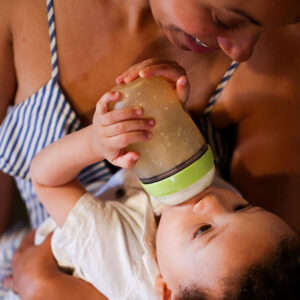
Ages 0-2 Feeding Recommendations
Getting your child off to a healthy start sets them up for a healthy life. Click an age to learn what and how to feed your baby, from birth to 24 months.
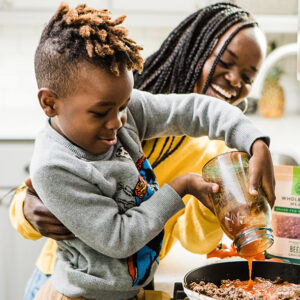
Ages 2-8 Feeding Recommendations
Childhood is a critical period for the development of eating behaviors that last into adulthood. Learn how to create healthy eating habits for 2-8 years old.
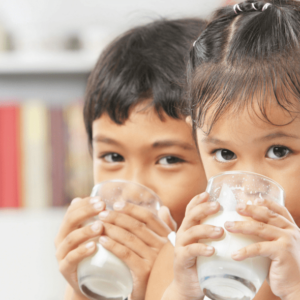
Ages 0-5 Beverage Recommendations
Visit HealthyDrinksHealthyKids.org to learn more about beverage recommendations for 0-5 year-olds and to access additional resources. Learn More at Healthy Drinks Healthy Kids
